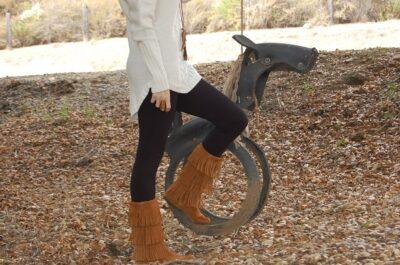
There are a lot of hunters in the world who take down some massive, 12-point buck, mount the head and pick the bones clean to feed their families, but what do they do with the hide? Some hunters like to tan their hides for display, but there are only so many random pieces of fur a person can have floating around the house.
I have found that a great way to use a tanned deer hide is to make your own boots or moccasins. They can be made in any size, for kids, men or women, for far cheaper than you could buy a pair of real leather boots or moccasins from even a closeout retailer. You can wear them as house slippers or fix soles to the bottoms and run around town in them. Women will especially love natural deer hide shoes because they’re so soft, warm and comfortable and can be made to look like the ultra-fashionable fringed moccasin boots that are so popular these days.
Here’s what you need:
1.) Deer hide. You can tan this yourself, if you are capable, but if not have it tanned by a professional. Tell them that you want part of it with the fur left on (This is optional, but recommended for house slippers and ankle-height shoes). Oftentimes, professional leather workers can get the hide a lot softer than you can. I’ve done my own several times and I’ve gotten close, but never quite as soft as the pros.
2.) A pattern for your boots or moccasins, in whatever shape or style you like, though for a beginner, simpler is going to be easier, so I would stick with whatever looks simplest. You can experiment with a more difficult pattern when you’ve mastered the skill.
3.) Heavy duty upholstery thread, or leather working thread and a heavy duty needle. (Also, a thimble or a leather thumb guard to protect your thumb; pushing the needle through the thick hide requires a bit more force than your average hand-stitching and you don’t want to end up with sore fingertips.)
4.) Material for the lining of your boot or moccasin. (Optional but recommended in order to preserve your shoes, protect your skin from blisters and make the shoes last as long as possible.)
5.) A rubber or wooden outer sole, if you are planning to make regular, heavy duty boots rather than moccasins. You can buy these at a lot of boot repair shops or online. Also, if you already have a pair of boots or shoes that you don’t wear and they have suitable soles, you can reuse them for your new deer hide boots.
6.) Heavy duty, water proof shoe repair glue, which can be bought online or in boot and shoe repair shops. This is really the only kind of glue that you’ll want to use for this sort of thing because you don’t want the soles of your boots to come off.
Make sure you have the pattern arranged on the hide so that you have enough to cut out all of the pieces for each foot. Cut out your pattern and separate the pieces for each foot so that you have a pile of left foot pieces and a pile of right foot pieces. This is just to keep you from getting confused and mixing up your pattern pieces.
When you have all the pieces properly arranged, you can start piecing them together and sewing. Start by lining up the part of the boot that will stretch across the top of the foot and stitching it to the piece that will serve as the sole. Given the thickness of the leather, it will be best to use a whip stitch with the raw edges to the outside. You can make your boots with the raw edges to the inside, but you will have to be careful to make very small stitches so that the foot inside the boot will not be irritated by the raised portion of the seam.
Once the top of the shoe has been securely stitched to the sole, it’s time to get the lining of your boot together. Since the material you will use for the lining will be much thinner and more pliable than the leather, you can use a sewing machine to sew its pieces together. This will save time and make sure that the lining is durable. Once the lining has been finished, you will put your foot in the lining and then into the boot. Make sure that your foot is comfortable in the boot with the lining so that you won’t experience any kind of irritation while you’re wearing your boots. After you have the lining situated comfortably, pull your foot out slowly so that the lining stays in place. It may take a couple of tries, but it’s important to be sure that there is enough lining in the boot so that your foot isn’t cramped.
When the lining is in the foot of the boot, it’s time to add the calves, or shafts of your boots. Piece the cutouts together and start sewing, using the same whip stitch that you used to sew up the foot, but this time, incorporate the edges of the lining into your stitches so that the lining will be securely attached to the boot and will stay in place as you slide your foot in and out.
Next, if you have opted for a sole, you will spread the heavy duty glue over the entire top side of the outer sole so that it covers all but about a quarter of an inch around the outside. Put your foot in the boot and apply the sole to your boot so that it fits the bottom of your foot properly and press all around the sole to be sure that the glue makes contact with the entire bottom of the boot. Then, wearing the boot, press your foot to the ground. Whatever glue comes out around the edges, wipe it off with your finger around the crease. Repeat on the other boot and then set them aside to dry for a few days.
Once the glue dries, your boots will be wearable. Of course, many people choose to waterproof and customize their boots. If you choose to go that route, you can use wood stains or fabric dyes to achieve the color you want and a good way to waterproof is by rubbing warm beeswax (softened with heat but still solid) all over the leather. Once the leather is coated, the wax will have a flaky, chalky appearance. Melt the wax into the leather with a hair dryer and let dry for a few hours.
Sign up for Off The Grid News’ weekly email and stay informed about the issues important to you











